
Andy Lloyd's Dark Star Blog

Blog 48 (March 2017)
More Dark Stars than Stars in Milky Way
For some time, astrophysicists have argued over how many Dark Stars there might be in the galaxy, with varying opinions. (Astronomers use several different names for these objects: sub-brown dwarfs, Y Dwarfs, 'planemos'). In this short article, I argue that new evidence presented about the stellar populations of open star clusters point towards there being more Dark Stars than stars in our galaxy.
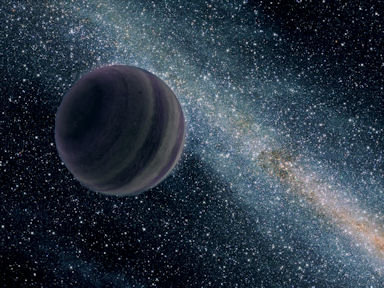
When I use the term 'Dark Star' in my book (1) and internet articles, I'm generally referring to gas giant planets/ultra-cool dwarf stars which are several times more massive than Jupiter, up to perhaps ~13 times as massive (at this point, the gas giant begins to burn deuterium and is reclassified as a brown dwarf). Most examples of these objects (perhaps more than a few million years old) are essentially dark. By contrast, very young examples light up more brightly, because they still retain some heat from their formation. It's a curious quirk of nature that these sub-brown dwarfs are actually smaller in size than Jupiter, despite being heavier. Because these objects are so small, and so dim, they are extraordinarily difficult to observe. Some have been found, but they are usually either extremely young (and therefore still burning brightly), or are exoplanets discovered orbiting parent stars (and so detectable through gravitational 'wobble' effects, or other means of finding massive exoplanets).
It has been my contention for some time that the populations of these objects are significantly underestimated. It is recognised generally that these ultra-cool dwarf stars may be free-floating objects in inter-stellar space, often as a result of having been ejected from young star systems as the fledgling planets in those systems jostle for position. Opinions about their numbers vary greatly among astrophysicists. There may be twice as many of these objects as stars, according to studies involving gravitational microlensing surveys of the galactic bulge (2). Other studies conflict with this conclusion, arguing that there may be as few as 1 object of 5-15 MJup size per 20-50 stars in a cluster (3). This discrepancy is important because the difference is perhaps as high as two orders of magnitude, and this ultimately affects our understanding of how many free-floating Dark Stars we can expect to find out there.
Their mass, lying between that of Jupiter and the deuterium-burning limit at about 13 MJup (4) seems to single Dark Stars out as rather special objects:
"An abrupt change in the mass function at about a Jupiter mass favours the idea that their formation process is different from that of stars and brown dwarfs. They may have formed in proto-planetary disks and subsequently scattered into unbound or very distant orbits." (2)
Therefore, if the number of free-floating sub-brown dwarfs (also sometimes known as "planemos") is on the high end of expectation, then it means that there are also likely to be far more of these objects in wide, distant orbits around their parent stars. This, in turn, increases the likelihood of there being a similar Dark Star object (or more) in our own immediate solar neighbourhood.
These free-floating sub-stellar Dark Stars are extremely difficult to locate, certainly in visible light. Within our own galactic neighbourhood, astronomers stand a better chances of imaging them using near infra-red sky searches, like WISE and 2MASS, as the sub-brown dwarfs' intrinsic size and density should produce sufficient heat to allow them to stand out from the frigid background of space. Even so, their age (1-10 billion years old) makes then exceedingly faint. It is perhaps no surprise, then, that the trawl across the sky by WISE for these local objects was not particularly successful (5).
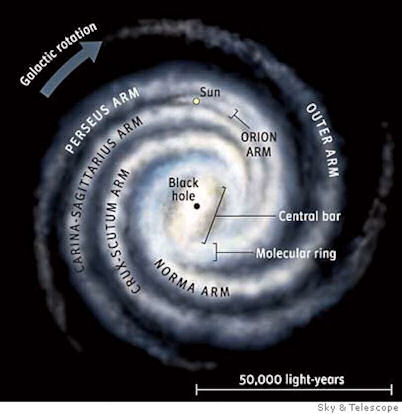
But these objects need not be distributed randomly through interstellar space. Studies of open clusters and associations of young stars have received much attention in recent years. These clusters may well host the brightest examples of low-mass sub-stellar objects in the solar neighbourhood. The youngest of these associations within 100 parsecs is TW Hya - more usually known as 'TWA'. This star cluster, located about 100 light years away, contains a few dozen 10-million-year-old stars, all moving together through space (6). It is known that many of TWA's low-mass objects are still missing - despite careful study by astronomers for over a decade. They were too faint to have been detectable by ESA's Hipparcos mission, which accurately determined the astrometry of a huge number of stars during the lifetime of its mission.
A new census of TWA has included computer simulations to try to fill in some of the gaps in the sub-stellar populations of this open cluster of stars (a bit like working out how many winnows there might be lurking within a large school of fish). The scientific team seemed particularly interested in working out whether the cluster might contain additional hidden objects in the ∼5–7 MJup range - very much in the 'Dark Star' territory! This interest has been prompted by recent discoveries by the near-infrared Two-Micron All Sky Survey (2MASS) of two such objects within the moving, open cluster:
"Two recent discoveries in particular demonstrate the interest of TWA as a laboratory for understanding this isolated planetary-mass population,”said Carnegie's astronomer Jonathan Gagné and co-authors. "2MASS J11193254-1137466 and 2MASS J11472421-2040204 are both candidate members of TWA with spectral types L7 that display signs of youth, and with estimated masses as low as 5-7 Jupiter masses. Their close distances to the Sun place them at the nearer side of the TWA spatial distribution."
"In order to determine whether or not there are more stand-alone planetary mass-sized objects like these in TWA, the astronomers undertook the calculation of an astronomical measurement called the initial mass function [IMF]. This function can be used to determine the distribution of mass in the group and to predict the number of undiscovered objects that might exist inside of it." (7)
The result of this calculation is that there are likely to be an additional 10 objects in the ∼5–7 MJup range in the TWA cluster (and perhaps more than 20, at the top end of their theoretical estimate).
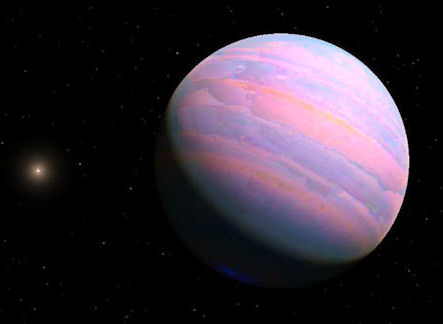
This large number of potential objects has surprised the astrophysicists, as it surpasses the numbers of low-mass objects which might be expected given the populations of stars in the census of TWA. But the new estimate is in keeping with other studies of galactic interstellar populations of sub-stellar objects of this size:
"This is much higher than what would be expected based on a log-normal IMF that is anchored on the higher-mass population of TWA. This possible over-density of objects in the planetary-mass regime is surprising, but consistent with recent estimates for the space density of objects at the deuterium-burning limit... (8), the recent discovery of a cold, planetary-mass Y dwarf at only 2 pc from the Sun (9), as well as results from micro-lensing surveys (1)." (10)
So, it looks like the number of free-floating Dark Stars may well be more than the number of actual stars in our galaxy after all. This inevitably leads to the following questions: If they are so numerous, and our near-infra red sky surveys have become ever more powerful, then why haven't we been detecting more of them? Is there an intrinsic property of these free-floating interstellar objects which is blinding them to us in infra-red and visible light? These are questions I have attempted to address in a previous paper which considers the potential for such objects to become wrapped in local, dark nebulae (11). The difficulty in detecting them certainly contrasts strongly with the growing numbers of late L-dwarfs (red/brown dwarfs) detected in several moving groups or stellar objects (12).
Written by Andy Lloyd, 4th March 2017
References:
1) Andy Lloyd "Dark Star: The Planet X Evidence" Timeless Voyager Press, 2005
2) T. Sumi et al. "Unbound or Distant Planetary Mass Population Detected by Gravitational Microlensing", Nature, 473, 349, 18 May 2011,
3) A. Scholz et al. "Substellar Objects in Nearby Young Clusters (SONYC). VI. The Planetary-Mass Domain of NGC 1333", The Astrophysical Journal, 756: 1, 9 August 2012
4) D. Spiegel et al. "The Deuterium-Burning Mass Limit for Brown Dwarfs and Giant Planets", The Astrophysical Journal, 727: 1, 3 January 2011,
5) Whitney Clavin "WISE Finds Few Brown Dwarfs Close To Home" NASA, 8th June 2012
6) Carnegie Institution for Science. "Hunting for giant planet analogs in our own backyard" 1 March 2017
7) Sci News "Astronomers Hunt for Free-Floating Planetary-Mass Objects in Solar Neighborhood" 1 March 2017
8) J. Gagné et al. "BANYAN. VII. A new population of young substellar candidate members of nearby moving groups from the BASS survey", The Astrophysical Journal Supplement Series, 219: 33, 2015,
9) Kevin Luhman "Discovery of a ~250K Brown Dwarf at 2pc from the Sun", AJL, 786: 2, 21 April 2014
10) Jonathan Gagné et al. "BANYAN. IX. The Initial Mass Function and Planetary-mass Object Space Density of the TW HYA Association" The Astrophysical Journal Supplement Series, 2017; 228 (2): 18
11) Andy Lloyd "The Cumulative Effect of Intermittent Interstellar Medium Inundation Upon Objects In The Outer Solar System" Feb 2016, DOI: 10.13140/RG.2.1.5112.5526 - an updated version (22/2/16) is available here:
12) A. Schneider et al. "A 2MASS/AllWISE Search for Extremely Red L Dwarfs -- The Discovery of Several Likely L Type Members of Beta Pic, AB Dor, Tuc-Hor, Argus, and the Hyades" The Astronomical Journal, March 2017
Red Giants and Planet Formation
This article will explore the potential for life to develop in the outer planetary systems of red giant stars. It will then discuss the death-throes of red giant stars, and whether the subsequent outward thrust of stellar material might provide another mechanism for free-floating planets in interstellar space.
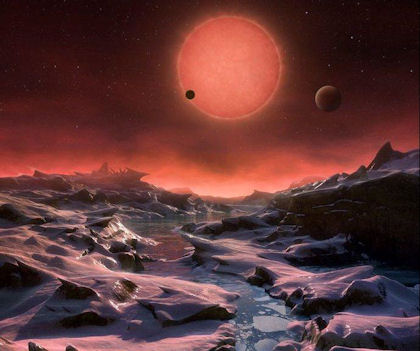
Exoplanets have already been found orbiting extremely old stars, one some 11 billion years old (1). This star, named Kepler-444, makes our own Sun, at a mere 4.6 billion years old, seem like an infant in comparison. The implication of this is that life could readily have got going early on in the history of the universe, long before the birth of our Sun. Furthermore, if these exoplanets were to benefit from a relatively stable stellar environment during that long timescale, then the chances of life evolving into higher forms are statistically more probable. Scale this up across trillions of stars, and the possibilities become clear.
Our own Sun has a shorter lifespan than this. Its main sequence life is expected to last another 5 billion years, by which point it will have burned up all of its hydrogen fuel. Then it will swell into a red giant star, before collapsing down into a white dwarf. For Earth, this post-main sequence (post-MS) phase of the Sun's life will be pretty disastrous. The Sun's expansion to a red giant will swallow the Earth up. However, a less catastrophic outcome might be expected for planets in the outer solar system, beyond, say, Jupiter. In fact, their climates might significantly improve - for a while, at least. The habitable zone of the solar system will expand outwards, along with the expanding star. Saturn's largest moon Titan, for instance, might benefit greatly from a far milder climate - as long as it can hang onto its balmy atmosphere in the red heat of the dying Sun.
The expansion of habitable zones, as late main sequence stars become hydrogen-starved, offers the potential for life to make a new start in previously frigid environments. The burning question here is how long these outer planets have to get life going before the red giant then withdraws into its cold white shell. A study published last year by scientists at the Cornell University's Carl Sagan Institute attempted to answer this question (2), choosing to examine yellow dwarf stars whose sizes range from half that of the Sun, to approximately twice its mass. They argue that the larger stars along this sequence could well have larger rocky terrestrial planets in their outer planetary systems than our Sun does (at least, insofar as we know it does!) This is because the density of materials in their initial proto-planetary disks should be that much greater for larger stars (3). Larger Earth-like planets in outer regions mean more potential for stable atmospheric conditions during the post-MS period under consideration. In other words, the growing red giant (which is shedding its mass pretty wildly at this point) would not necessarily blast away an outer planet's atmosphere if that rocky planet had sufficient gravity to hold onto it.
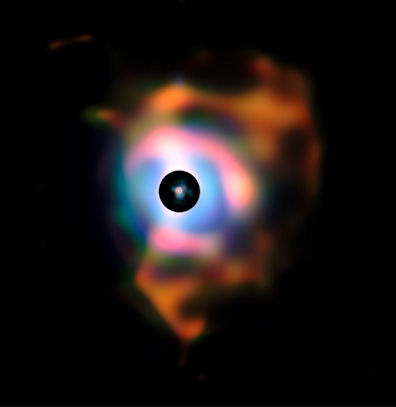
Image Credit: ESO (5)
However, the larger stars enjoy much shorter post-MS phases than their cooler cousins. So the potential for larger Earth-like planets in the outer reaches of their surviving planetary systems is offset by the shorter time period required to allow life to get a foothold. That might not be as much of a problem as it first appears, however:
"Life may become remotely detectable during the post main sequence lifetime of a star. First, life may be able to evolve quickly (i.e. within a few million to a hundred million years). Secondly, it is not necessary for life to evolve during the post-MS phase. Life may have started in an initially habitable environment and then moved subsurface, or stayed dormant until surface conditions allowed for it to move to the planet's surface again, like in a star's post-MS phase. Lastly, life could have evolved during early times on a cold planet located beyond the traditional habitable zone, remaining subsurface or under a layer of ice until emerging during the post-MS phase." (3)
That said, the cooler main sequence stars (those with a fraction of the Sun's mass) enjoy a much, much longer post-MS period - a 'retirement' period which might last as long as 9 billion years! But, these same stars also enjoy very long main sequence lifetimes, meaning that some of the oldest, coolest stars have yet to reach the point where they might have burned up all of their hydrogen fuels within the actual lifetime of the universe:
"None of the cool late K [orange dwarf] and M [red dwarf] stars have yet reached the post-MS phase, making the lifetime in the post-MS HZ for cool stars a prediction, not an observable quantity." (3)
So, we need not concern ourselves particularly with orange dwarfs and red dwarfs - the Sun's smaller stellar cousins. They simply take too long to burn out. The bigger the star, the quicker it moves through its lifecycle (to complicate matters further, this is also dependent upon its inherent metallicity, which tends to be greater in stars as the universe ages). So, stars larger than the Sun move through their post-MS period much quicker than their cooler cousins (4). That period of time between the fully expanded red giant phase, and the essentially deceased white dwarf phase, contains mysteries which have yet to be unravelled. Whilst discussing the decreasing size of the famous red giant star Betelgeuse, Edward Wishnow, a research physicist at UC Berkeley's Space Sciences Laboratory, was quoted making the following point about end stage red giants:
"Considering all that we know about galaxies and the distant universe, there are still lots of things we don't know about stars, including what happens as red giants near the ends of their lives." (5)
The red supergiant Betelgeuse is currently shedding huge amounts of itself into space, forming a spectacular planetary nebula (6). These nebulae are created around red giants as they move relatively rapidly through a sequence of internal changes. They are essentially throbbing and pulsating back and forth as the increasingly unstable red giant star expands and contracts in upon itself, as it feeds upon an increasingly heavier diet of internal nuclear fuels:
"During the latter parts of the Red Giant stage of a star, the star begins to throb and pulsate. The helium-burning shell collapses into the core when its contents are fused into carbon. There is a brief shut-down of one form of nuclear fusion and the star shrinks slightly. Then a new shell of helium ignites and blows the star outward. This shrinking and expanding is called the Asymptotic Giant Branch lifestage of a star, and during this time, the star sheds much of its outer material into space in huge rings of gas and dust." (7)
And this is where things get interesting. The image opposite, of the red star surrounded by a encircling planetary nebula, is of the red giant V838 Monocerotis, in the constellation Monoceros. This red giant is blowing its outer layers into space without actually turning into a nova (8). It appears like a red star wrapped up in a dusty nebula. Similar, then, to the imagery I have described for a Dark Star in our own backyard. However, this is on a titanic scale, at the dying end point of a star's life. But it creates an interesting precedent for the kind of structure I've been discussing for a much, much smaller red object, closer to home; itself perhaps wrapped up in a cloud of obscuring dust (9, 10, 11). Let's explore this connection further.
Non-conventional Planet Formation
Could massive 'clumps' of the red giants' planetary nebulae get interred into interstellar space in great numbers, and after drifting through the darkness of interstellar space, end up getting picked up by the gravitational fields of main sequence stars, like the Sun? I wonder whether the materials driven forth by the red giant could be a source of clumps of dark interstellar material sizeable enough to form massive gaseous planets within them, like Dark Stars and other sub-brown dwarfs.
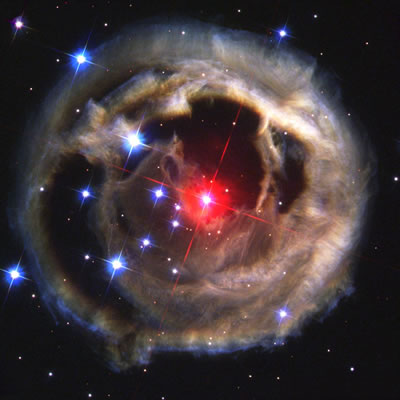
Image Credit: NASA/HST (8)
This stunning picture of the planetary nebula in Monoceros relied upon a chance flaring of red giant starlight illuminating the dusty nebula beyond, a phenomenon known as a 'light echo' (8). It may only have been blind luck that this image was even captured. As the red giant dies back, and in the absence of other illuminating sources, this nebula will become progressively darker. Arguably, then, dark nebulae may be emerging from these dying stars regularly, but never witnessed by astronomers.
Back in January, I wrote about the 'spaghettification' of stars by black holes, and how this debris field of matter is flung out into the rest of the Milky Way by the supermassive black hole which lies at the galactic centre (12). Clumps of this strewn material, or 'spitballs', are thought to become sizeable free-floating planets (13), including sub-brown dwarfs. Coming back to end-stage red giants, might not these expanding planetary nebulae also provide a non-conventional environment for planetary formation, as matter clumps together in the eddies of this outwardly expanding rush of material? Chips off the old block, one might say.
The more we come to appreciate how much material is ejected from young planet-forming star systems, binary star systems (14), star-crushing black holes and red giants, the more we need to accept that interstellar space is far from empty. On the contrary, like a swirling junk yard, it is a vast repository of broken stars, planets and dark nebulae, consisting of material which is either the unfinished detritus of creation, or from repetitive cosmic recycling. This non-uniform stream of material moves around the galaxy, like the stars - but is not sufficiently lit by them to be observable.
The stars clear away this material from their own local environments through the action of their solar winds, their heliopause borders and the gravitational wells of the stars themselves. As we happen to exist within one of these solar bubbles, and our subjective viewpoint is taken from within them, we assume a great deal about the conditions beyond (11). Because we cannot see stuff out there, besides the obvious denser patches lit internally by stars (like star-forming nebulae, and giant molecular clouds), we conclude that interstellar space is largely empty. But then, where does all this junk end up?
I suspect much of it aggregates into sub-stellar free-floating planets, forming dark mini-systems enveloped in shrouds of gas and residual matter. So, instead of an opaque fog of matter strewn across space, which we might readily observe, there are instead tiny rain drops of condensed matter invisible in the starlight. A galaxy full of dark stars and free-floating planets; felt, but unseen.
Written by Andy Lloyd, 12th March 2017
References:
1) Campante et al "An ancient extrasolar system with five sub-Earth-size planets", The Astrophysical Journal, 26 January 2015,
2) Melissa Osgood "Hunting for hidden life on worlds orbiting old, red stars" Cornell University, 16 May 2016
3) Ramirez, R. & Kaltenegger, L. “Habitable Zones of Post-Main Sequence Stars,” The Astrophysical Journal, 823: 6, 14pp, 15 May 2016
4) The Astrophysics Spectator "Red Giant Evolution" Issue 3.19, 19 October 2006,
astrophysicsspectator.org article
5) Robert Sanders "Red giant star Betelgeuse mysteriously shrinking" 09 June 2009
6) European Southern Observatory - Press Release 1121 "The Flames of Betelgeuse: New image reveals vast nebula around famous supergiant star" 23 June 2011,
7) Hopkins On-Line Astronomy "Red Giant Stars - Introduction"
8) NASA "Light Echoes From a Red Supergiant" 23 March 2008
9) Andy Lloyd "Dust in the Winged" 23 June 2016,
andylloyd.org/darkstarblog39.htm
10) Andy Lloyd "Interstellar Planet Formation" 8th-17th July 2016
andylloyd.org/darkstarblog40.htm
11) Andy Lloyd "The Cumulative Effect of Intermittent Interstellar Medium Inundation Upon Objects In The Outer Solar System" Feb 2016, DOI: 10.13140/RG.2.1.5112.5526 - an updated version (22/2/16) is available here:
12) Andy Lloyd "The Galactic Core Spits out Dark Stars" 15 January 2017
www.andylloyd.org/darkstarblog46.htm
13) Harvard-Smithsonian Center for Astrophysics Press Release 2017-01 "Our Galaxy's Black Hole is Spewing Out Planet-size "Spitballs"" 6 January 2017
14) Ramin Skibba "Binary stars shred up and shove off their newborn planets" 13 January 2017
"Planet Nine: The Movie"
Mike Brown, one of the
two astrophysicists who proposed the existence of Planet Nine in January
2016 (1), is a professor at CalTech, and teaches a variety of courses.
Image credit: Mike Brown
One of them, entitled "The Science of the Solar System", is available - for free - online through Coursera (2). The course runs every three months. This month, Dr Brown added a video about Planet Nine to the course content, a 20 minute excerpt from which is available on YouTube (3).
Written by Andy Lloyd, 13th March 2017
References:
1) Konstantin Batygin & Michael Brown "Evidence for a Distant Giant Planet in the Solar System" The Astronomical Journal, 151:2, 20 January 2016,
2) Mike Brown "The Science of the Solar System" Coursera
coursera.org/learn/solar-system
3) Mike Brown's Planets "Planet Nine"
New Dark Star Book
A lot of progress has been made about Planet X over the last 12 years or so since the publication of my non-fiction title 'Dark Star'. During that time, I've been keeping my readers updated regularly on press releases about related scientific discoveries, as well as new ideas which might work for the shape and identity of the Planet X body.
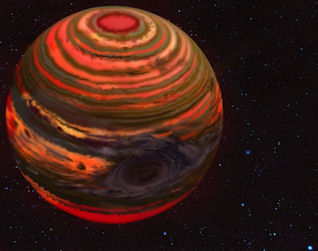
The result is a huge spread of web-pages and blogs which, beyond an obvious chronological order, are not easy to navigate. It's high time I brought the whole thing together into a readily digestible format, as well as incorporating various new ideas into the mix. Clearly, the best format for that is a new non-fiction book. I'm hard at work writing it at the moment. If you would like to be informed when the book is released, please drop me an email and I'll send you a message at the time of publication:

You can keep informed of updates by following me on Twitter:
![]()
Or like my Facebook Page: https://www.facebook.com/darkstarandylloyd